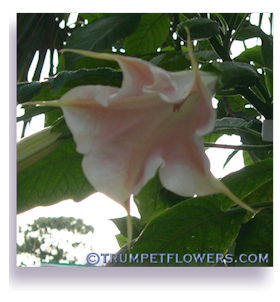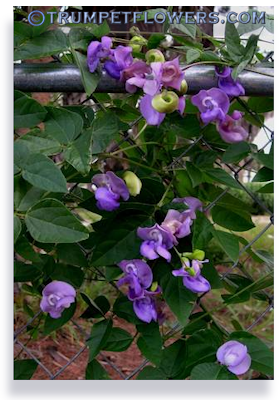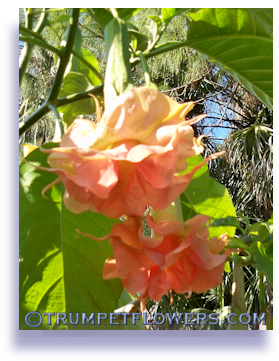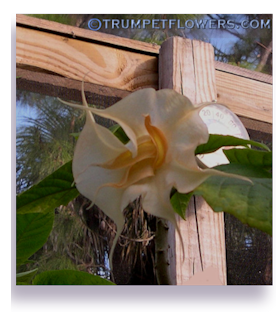Brugmansia Seed
Starting
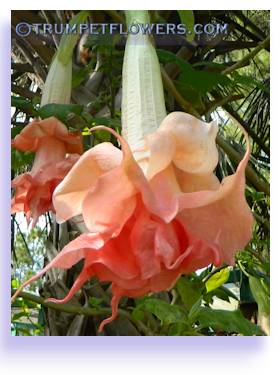 Brugmansia seeds are great fun to start up on your own. You have the opportunity to create your own seed pods if you like, or you can always buy viable seeds
if you haven't made any of your own crosses yet.
Brugmansia seeds are great fun to start up on your own. You have the opportunity to create your own seed pods if you like, or you can always buy viable seeds
if you haven't made any of your own crosses yet.
It is the nature of brugmansia to throw mostly white flowered plants, even if you have made (or bought) a great cross. But out of every 10 or so trees, you might get a really exceptional, colored up single, double or even triple with an unusual enough bloom that it may be worth registering. Grow them for the fun, or grow them for the more serious side of naming your own new cultivar, it is up to you.
It takes anywhere between 9 months and up to 18 months to get a bloom from a brugmansia that has been started from seed. This depends a lot on the plant's original parentage, and your growing conditions and climate. It is also a good idea to not expect too much out of the first couple of flushes, and allow the plant to continue to mature before deciding it is just a plain old white. I have had many of them do this, only to set out flushes a few times later that were beautifully colored up with frilly orange skirts, etc. Give it some time then, before thinking to yourself that you don't have anything special.
I've heard of it taking longer for some. Climate and the original brugmansia cross plays into length of time until young ones bloom too. Brugmansia are heavy feeders, and fast growing. Not supplying them with brugmansia style fertilizers at least once to twice a week, and upsizing the pots as they grow, could definitely stunt the appearance of flowers. I am a strong supporter of using Superthrive that is locally available, or make your own brugmansia tea. Either one of these special teas will get your seedlings into trees quicker, and with larger, more vigorous blooms faster.
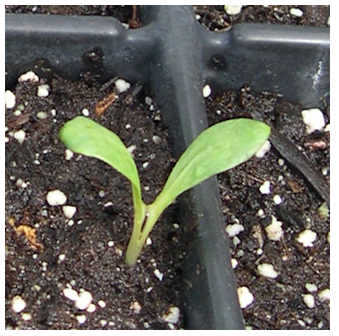 This year I made a couple of crosses I will plant for the purpose of following through this page. Dorthea X Dalai Lama. and L∼Noid X Balao. I am going to use photos of this seed set to show you the basics of getting them up and going. Both sets of 9 seeds each were planted on August 21st, 2012.
This year I made a couple of crosses I will plant for the purpose of following through this page. Dorthea X Dalai Lama. and L∼Noid X Balao. I am going to use photos of this seed set to show you the basics of getting them up and going. Both sets of 9 seeds each were planted on August 21st, 2012.
It is best to start out with relatively fresh seeds. Although brugmansia seed remain viable for as much as 7 years (it has been reported to me as thus by fellow hybridizers of brugmansia) but it always seems that the fresher, the faster they will germinate. Mine usually appear within 3 weeks, usually 2. In the deep south, start them out in early spring, or late summer in a protected area.
Prepare the angel trumpet seeds ahead of time by first chipping a small corner of the corky coating with a fingernail clipper. Then dampen them in a moistened paper towel that you have rolled then in and placed in a baggie. Place the baggie under the kitchen sink or ideally, on top of the refrigerator. Here it is warm from heat rising out of the back of the fridge. Check them daily, and change the paper towel every other day so it does not become fungal. After you see the little roots begin to peek out, you are ready to begin potting them.
Use the seed starting mix or buy a commercial seed starting soilless mix. Fill a flat with the 10 or so seeds you have on hand. Most hybridizers sell them in sets of 10. Allow the soil mix to soak first, and if you have rainwater, I suggest using it over tap or well water. After the soil is throughly wettened, place one seed in each pot, and lightly cover over with some remaining soil mix, usually not more than about a quarter or so of an inch.
Be sure you have a permanent marker and have made a tag to label them up with. Place the date on the tag too. This will help you keep track of your germination rate. If you like to keep a journal, do so. It can help you learn for future experience. I normally keep track of the date, the amount of seeds, the cross, the mix, and the temperatures until they germinate. You do not have to keep track of all that data unless you want to. It is also good practice to keep track of the name of the hybridizer who sold (or gave) you the seeds. This way you know who to credit if you ever have a plant worth registering. It also helps the registry to keep better track of valuable information.
After the seeds come up, keep them in a semi shaded, protected area for about a month. If you have rainwater available, continue to give it to them, keeping them moist but not drenched. Use a dusting of Actinovate on the soil surface if fungus or fungus gnats become an issue. Water it in, as ants seem to enjoy harvesting it.
After a month, give them a half∼weakened dose of regular fertilizer mixed with half∼strength kelp powder. Continue to give them this every two weeks.
When the roots begin to peek out the bottom of the pots, repot into a planter a few sizes larger. After they are 10 inches tall, begin fertilizing them once a week as you do regular sized brugmansia, and give them more exposure to sunlight. From now on you can treat them as adult plants. Continue to enlarge the pots they are in as soon as you see the roots, so they are at optimum growth rate.
Liz Fichtl, a highly regarded brugmansia hybridizer, has written up a blog on her take of brugmansia seed. It would be of great benefit for you to read it. I am trying to help you get the seed up, Lizzy will teach you even more about what seed to try to grow and why. Here is the link: Guidelines for purchasing Brugmansia Seeds. Lizzy will explain in great detail much more about growing out brugmansia seeds. She's been at it for quite some time, so you can trust her on this. :)
If you are looking for a reputable hybridizer to buy brugmansia seeds from, try Edna Murphee from Brugmansia Growers International. She has some excellent crosses for sale right now. Here is a link so you can get some for yourself: Brugmansia Seeds
Note:
One more point to make. It is good, acceptable practice amongst hybridizers to consider giving them credit when and if you have one grow out and it becomes a keeper, if the seed was given to you. It is okay to not follow this practice if you paid for the seed. Personally, I would find it in good keeping to go ahead and let the hybridizer of the original pod know about my intent to register, and allow them some input, whether or not I paid for the seed, but as previously stated, it is not your obligation to do so if you bought the seeds. My personal reasons for this include keeping good track of the bloodline of the plant, and knowing where and what climate it was grown out in, year, etc. Here's a link to the Official Brugmansia Registry: World Registry of Brugmansia.
If you would like more information on brugmansia and the registering of your cultivars, please visit Brugmansia Growers International. There are several other protocols that are noteworthy of a proper registry, and I will not go into those details here. BGI will.

Here's more reading on Brugmansia and their Seed pods.
Tags: start brugmansia seeds, brugmansia seeds brugmansia seeds, get started with brugmansia seeds, germination rate, brugmansia, viability of brugmansia seeds,
This entry was posted on February 15th, 2012 and is filed under Brugmansia Information.
